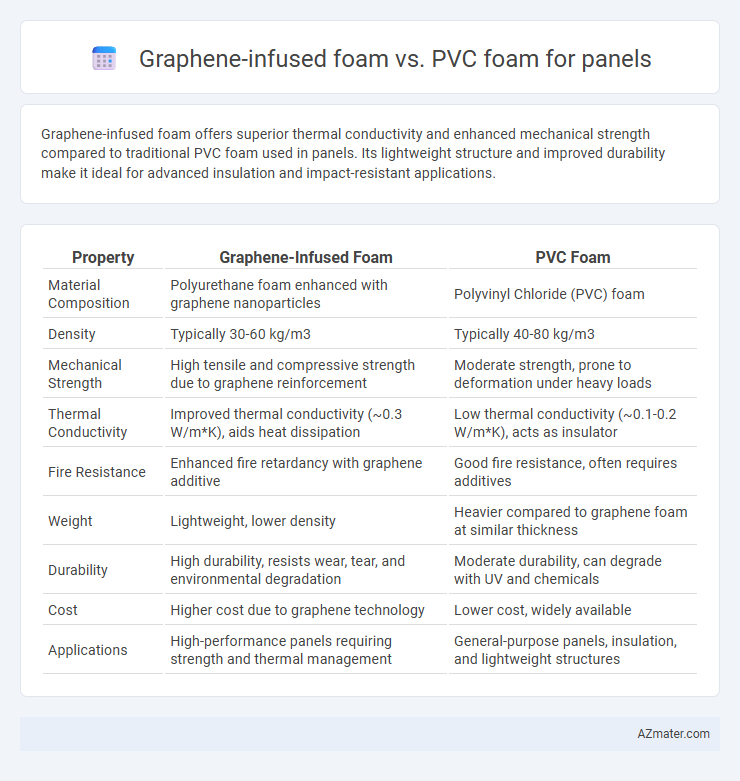Graphene-infused foam offers superior thermal conductivity and enhanced mechanical strength compared to traditional PVC foam used in panels. Its lightweight structure and improved durability make it ideal for advanced insulation and impact-resistant applications.
Table of Comparison
| Property | Graphene-Infused Foam | PVC Foam |
|---|---|---|
| Material Composition | Polyurethane foam enhanced with graphene nanoparticles | Polyvinyl Chloride (PVC) foam |
| Density | Typically 30-60 kg/m3 | Typically 40-80 kg/m3 |
| Mechanical Strength | High tensile and compressive strength due to graphene reinforcement | Moderate strength, prone to deformation under heavy loads |
| Thermal Conductivity | Improved thermal conductivity (~0.3 W/m*K), aids heat dissipation | Low thermal conductivity (~0.1-0.2 W/m*K), acts as insulator |
| Fire Resistance | Enhanced fire retardancy with graphene additive | Good fire resistance, often requires additives |
| Weight | Lightweight, lower density | Heavier compared to graphene foam at similar thickness |
| Durability | High durability, resists wear, tear, and environmental degradation | Moderate durability, can degrade with UV and chemicals |
| Cost | Higher cost due to graphene technology | Lower cost, widely available |
| Applications | High-performance panels requiring strength and thermal management | General-purpose panels, insulation, and lightweight structures |
Introduction to Panel Core Materials
Graphene-infused foam offers superior strength-to-weight ratio and enhanced thermal conductivity compared to traditional PVC foam, making it an innovative choice for panel core materials. PVC foam remains popular due to its cost-effectiveness, chemical resistance, and ease of fabrication in various panel applications. Advanced graphene composites improve mechanical performance and durability, positioning them as a cutting-edge alternative in lightweight panel core solutions.
What is Graphene-Infused Foam?
Graphene-infused foam is an advanced material enhanced with graphene nanoparticles, significantly improving its mechanical strength, thermal conductivity, and durability compared to traditional foams like PVC foam. The integration of graphene creates a lightweight, highly resilient panel core that offers superior impact resistance and energy absorption. This innovative composite outperforms PVC foam in applications requiring enhanced performance, such as aerospace, automotive, and high-end construction panels.
Understanding PVC Foam in Panels
PVC foam in panels offers excellent chemical resistance, lightweight properties, and good thermal insulation, making it a popular choice for construction and marine applications. Its closed-cell structure provides enhanced moisture resistance and durability, which helps prevent deformation and decay over time. Compared to graphene-infused foam, PVC foam is more cost-effective but lacks the superior strength and conductivity properties that graphene additives provide.
Mechanical Strength Comparison
Graphene-infused foam demonstrates significantly higher mechanical strength compared to PVC foam, offering enhanced tensile and compressive strength due to the superior properties of graphene nanomaterials. Its improved stiffness and impact resistance make it more suitable for structural panel applications requiring durability and lightweight performance. PVC foam, while more cost-effective, generally exhibits lower mechanical robustness and less resistance to deformation under mechanical stress.
Weight and Density Differences
Graphene-infused foam offers a significantly lower density compared to traditional PVC foam, resulting in lighter panels that enhance ease of handling and reduce overall structural weight. The incorporation of graphene increases the foam's strength-to-weight ratio, allowing for thinner, more durable panels without compromising performance. In contrast, PVC foam typically has higher density, making it heavier and less efficient for applications requiring lightweight materials.
Thermal and Electrical Conductivity
Graphene-infused foam exhibits significantly enhanced thermal conductivity compared to PVC foam, facilitating more efficient heat dissipation in panel applications. Its superior electrical conductivity enables improved electromagnetic interference shielding and electrostatic discharge protection, which PVC foam lacks due to its insulating properties. The integration of graphene nanoparticles into foam matrices results in a lightweight, durable material ideal for advanced thermal management and electronic performance in panels.
Environmental Impact and Sustainability
Graphene-infused foam offers enhanced durability and reduced material usage, lowering its overall environmental footprint compared to traditional PVC foam, which relies on petrochemical processes and often generates hazardous waste during production and disposal. The biodegradability and recyclability of PVC foam remain limited, whereas graphene-enhanced composites can potentially improve lifecycle sustainability by extending product lifespan and facilitating more efficient recycling. Life cycle assessments (LCA) indicate that adopting graphene-infused foam panels can significantly reduce carbon emissions and toxic byproducts associated with panel manufacturing and end-of-life treatment.
Durability and Lifespan Analysis
Graphene-infused foam exhibits exceptional durability due to graphene's superior mechanical strength, enhancing resistance to wear, impact, and environmental degradation compared to traditional PVC foam. This advanced composite material maintains structural integrity significantly longer, extending the panel's lifespan by up to 50% under similar conditions. PVC foam, while cost-effective, tends to degrade faster under UV exposure and mechanical stress, limiting its durability and overall longevity in demanding applications.
Cost Considerations and Availability
Graphene-infused foam panels generally carry a higher price point compared to traditional PVC foam due to the advanced materials and manufacturing processes involved. PVC foam remains widely available and cost-effective, making it a preferred choice for large-scale projects with tight budgets. Supply chains for graphene-infused foam are still evolving, which can limit availability and increase lead times compared to the well-established distribution networks for PVC foam panels.
Future Trends in Panel Core Technology
Graphene-infused foam offers enhanced mechanical strength, thermal conductivity, and lightweight properties, driving innovation in panel core technology compared to traditional PVC foam. Future trends emphasize sustainable, high-performance materials with improved durability and energy efficiency, positioning graphene composites as a leading solution. This shift supports evolving industry demands for smarter, more resilient building and aerospace panels.

Infographic: Graphene-infused foam vs PVC foam for Panel
 azmater.com
azmater.com